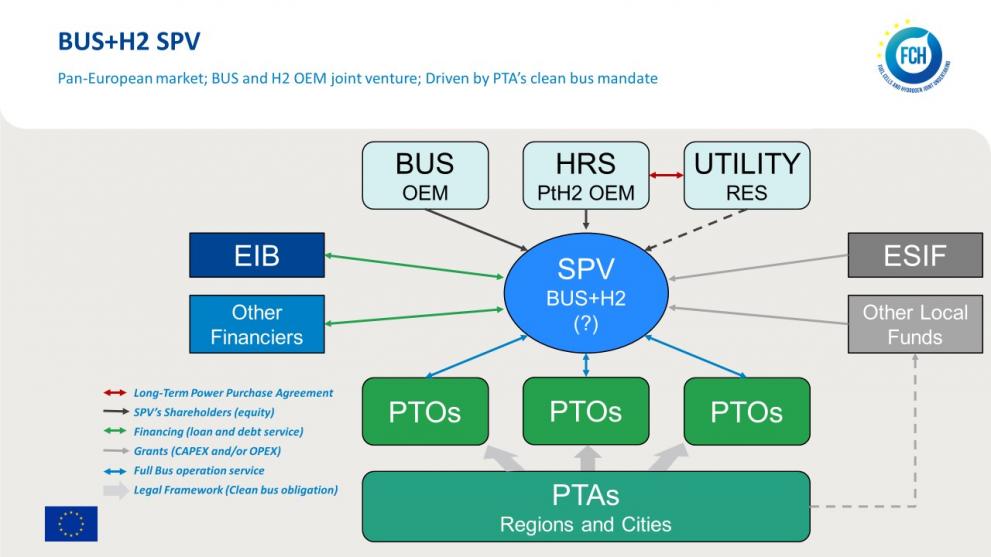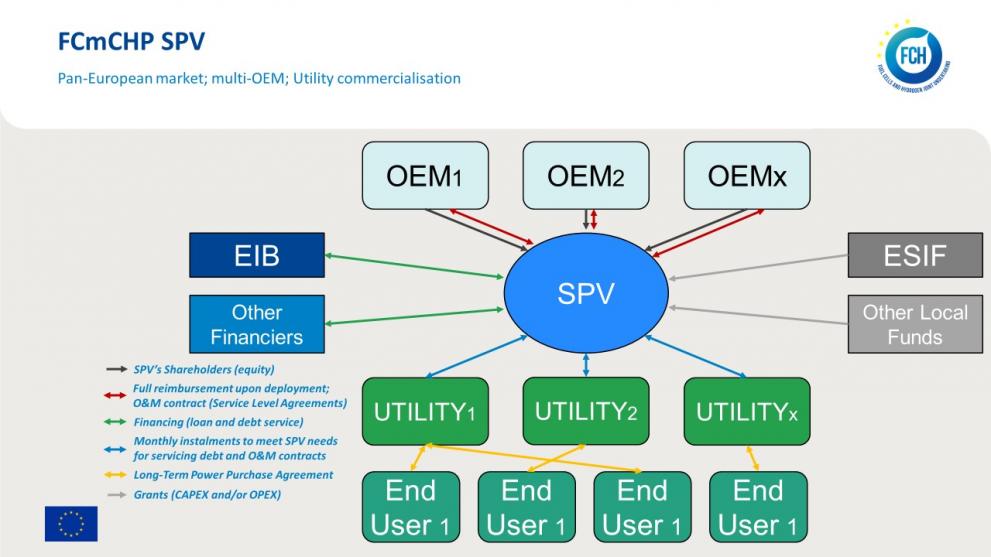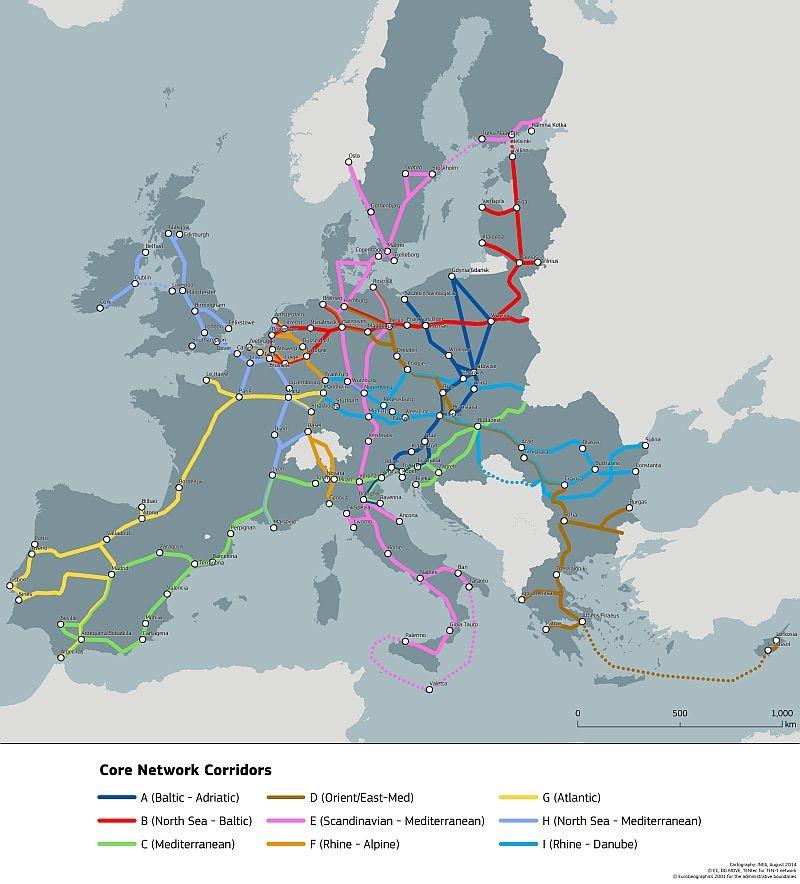The Programme Office aims at being perceived as a partner to which beneficiaries of the FCH JU funding may reach out in their quest for designing disruptive and/or complex business models that may lead to accelerated market uptake of their products. In order to explore and facilitate access to additional financing schemes the FCH 2 JU has been working with and establishing close relationship with several EIB departments, namely the InnovFin EDP/ InnovFin Advisory hub; Equity, New products and Special Transactions; Growth Capital and Innovation Finance; Transport Operations. The Programme Office has been focusing on more market ready technologies in both the transport and the energy sectors, namely (1) FCE Buses or private FCEV fleets and respective hydrogen infrastructure (hydrogen production, storage, logistics and HRS) or (2) massive deployment of mCHP.
To better advise on complex business cases the FCH JU is frequently promoting and attending meetings and conference calls between FCH 2 JU project beneficiaries and the EIB or any other financing institution or private investor(s) to potentiate matchmaking between them. It also works on trying to address the main barriers to financing in advance, strengthening in advance the business concepts and thus spurring their bankability chances. In the same line, it also advises FCH JU project beneficiaries on Project Development Assistance facilities they may reach out to better structure their business cases.
While advice is given on demand, the FCH JU will share experiences and lessons learned with the FCH community in general, always ensuring confidentiality whenever deemed relevant. You may find bellow some generic examples of ideas and advice provided for different technologies’ roll-out plans.
FCE Bus Roll- out
Working with the EIB and its InnovFin Advisory hub staff and the FCH JU beneficiaries on alternative business models that may enable the creation of a special purpose vehicle (SPV). The SPV would enable the better management and mitigation of most risks related with the introduction of new technologies in the market like fuel cell buses and related hydrogen infrastructure. A wider SPV would also enable the demand aggregation to attract International Financing Institutions (IFI) like the EIB and contribute towards raising the bankability of such project(s).
Example:

CHP scale-up
Like or the FCE bus roll-out mentioned above, upon their request the FCH 2 JU has also organised face-to-face meetings between the EIB and a FCH 2 JU project beneficiary to explore pathways for financing its plan for industrial plant expansion. In addition, financing of SPVs that may aggregate demand and enable the development of more market driven and aggressive business models for deploying technology directly related with demonstration projects receiving support from the FCH 2 JU was explored. Follow-up meetings were held in view of widening the attendants list to those beneficiaries at the same level of maturity in view of accessing the willingness to join forces for a Pan-European multi-brand mCHP SPV. Although focused on the most mature mCHP products, this potentially new SPV and business model path has the potential to be applied for other technologies supported by the FCH 2 JU as well (to be discussed and developed upon request).
Example:

EU wide HRS network
IPCEI is the acronym for Important Project of Common European Interest (or just PCI as it is commonly known).
In June 2014 the Commission adopted a Communication waiving State-aid rules on IPCEIs. It aimed at encouraging Member States (MS) to channel their public spending to large transnational projects that make a clear contribution to economic growth, jobs and the competitiveness of Europe (communication available here). It reads that MSs may fill the funding gap to overcome such market failures (because of the significant risks and the transnational cooperation such projects entail) and boost the realisation of projects that otherwise would not have taken off.
Key features of the IPCEI communication are:
- Extending existing provisions on IPCEIs to any sector of the economy – making it much easier to support important projects with a clear European dimension in areas such as R&D, cross-border transport or energy that would otherwise have needed to be assessed under several different sets of rules;
- Diversifying forms of support – MSs may grant repayable advances, loans, guarantees or grants to IPCEIs;
- Increasing aid intensity – public support may cover up to 100% of the funding gap on the basis of a large set of eligible costs;
- Allowing aid for the first industrial deployment of an R&D project – during the up-scaling of the pilot facilities and the testing phase.
This concept is being used by the Energy branch of Connecting Europe Facility (CEF) to define priority projects for their funding. In the case of Energy, the EC (DG ENER) has drawn up a list of 195 key energy infrastructure projects known as “Projects of Common Interest” (PCIs) to help create an integrated EU internal energy market and for reaching the EU's energy policy objectives of affordable, secure and sustainable energy. PCIs may benefit from (1) accelerated planning and permit granting; (2) a single national authority for obtaining permits; (3) improved regulatory conditions; (4) lower administrative costs due to streamlined environmental assessment processes; (5) increased public participation via consultations; (6) increased visibility to investors and access to financial support totalling €5.35 billion from the CEF during 2014-2020. The funding is intended to speed-up the projects and attract private investors.
To become a PCI, a project must have a significant impact on the energy markets and market integration of at least two EU countries, boost competition on energy markets and boost the EU's energy security by diversifying sources, and contribute to the EU's climate and energy goals by integrating renewables.
The first list of PCIs was published in 2013. The list is updated every two years to integrate newly needed projects and remove obsolete ones. The link to an interactive PCI’s map and a list of them can be found here and here.
For the transport sector the CEF considers the concept of “Core network corridors” instead of the PCIs they use for the energy sector. (see this page for the core network)
It should be feasible to work in setting-up a network of HRS under either the energy or the transport Trans-European Networks (TEN). The picture below identifies the current Core network corridors established under the TEN-T.

A link to the TENtec Public Portal providing a comprehensive overview on the European Commission's work in relation to the Trans-European Transport Network (TEN-T) and raising citizens' awareness of the benefits for developing the TEN-T policy, which fosters clean, safe and efficient travel throughout Europe, can be found here. TENtec Public Portal provides timely information to the public (citizens and professionals) through interactive maps, a map library and various audio-visual elements.
According to CEF regulation (Regulation (EU) No 1316/2013, downloadable via this link ), a potential PCI project would get its support under #2 article 4 – specific sectoral objectives (in the transport sector) – which reads that “the CEF shall support projects of common interest (…) that pursue the objectives set out below (…): (b) ensuring sustainable and efficient transport systems in the long run, with a view to preparing for expected future transport flows, as well as enabling all modes of transport to be decarbonised through transition to innovative low-carbon and energy-efficient transport technologies, while optimising safety. The achievement of this objective shall be measured by: (i) the number of supply points for alternative fuels for vehicles using the TEN-T core network for road transport in the Union; (ii) the number of inland and maritime ports of the TEN-T core network equipped with supply points for alternative fuels in the Union; (…)”.
This opens the door for FCH community to push for a network of HRS across Europe’s (energy and) transport core networks. Energy storage projects are not to be excluded as potential PCIs neither due to their positive impact in terms of both the security and the environmental pillars of the EU energy strategy.
The TEN-T network is supported through different Programmes. In that respect, projects on this network are eligible to receive EU grants, as a rule in a form of co-financing, notably from the TEN-T Programme (managed by INEA, the Innovation & Networks Executive Agency), Cohesion fund, ERDF and the Horizon 2020. TEN-T projects may also benefit from loans and guarantees from the European Investment Bank (EIB).
The FCH JU is assessing the opportunity to launch a coordinated approach to a PCI for HRS in Europe. This would pave the way for reaching out to additional funding sources for the deployments of HRS throughout Europe’s transport networks.
